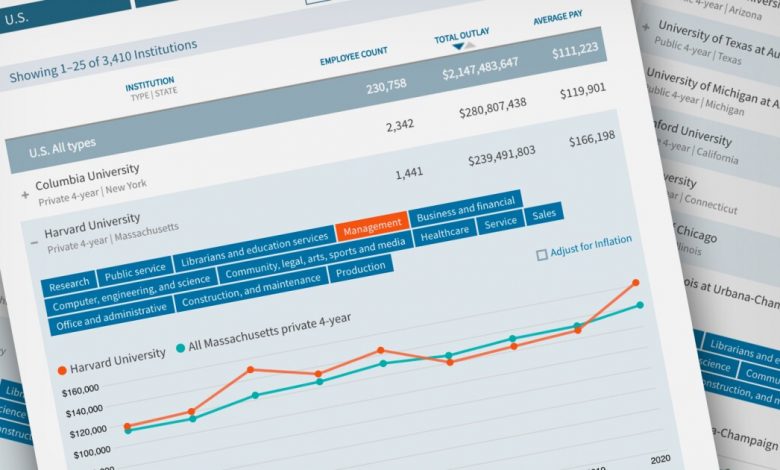How Much Has Noninstructional Employee Pay Changed Over Time?

Here’s a sector-by-sector look at changes in average annual pay for workers in noninstructional jobs from 2012-13 to 2020-21. Jobs that fall into the category of noninstructional include business and financial operations; computer, engineering, and science; librarians, curators, archivists, and academic and other education services; management; and office and administrative support.
Salary data for the 2020-21 academic year:
About the data
Data come from the U.S. Department of Education’s Integrated Postsecondary Education Data System (Ipeds), which comprises degree-granting U.S. colleges that participate in Title IV funding. The faculty data refer to full-time noninstructional staff as of November 1 of the corresponding academic year.
In reporting staff-pay data since 2012-13, Ipeds provides the total number of staff members and the outlay in salary to those members.
“Type” is based on highest degree granted. Salaries at colleges with less than three staff of a given type are omitted for privacy concerns.
Average salaries for U.S., states, and types are generated by multiplying the overall outlay at all applicable institutions (U.S., state, or type) divided by the number of staff of that type.
Staff categories are based on Bureau of Labor Statistics categorization. The represented occupation categories are as follows (original listing name in Ipeds is included along with description if the presented label is different):
- Research: An occupational category used to classify persons whose specific assignments customarily are made for the purpose of conducting research. Regardless of title, academic rank, or tenure status, these employees formally spend the majority of their time conducting research.
- Public service: An occupational category used to classify persons whose specific assignments customarily are made for the purpose of carrying out public-service activities such as agricultural-extension services, clinical services, or continuing education. Regardless of title, academic rank, or tenure status, these employees formally spend the majority of their time carrying out public-service activities. This category includes employees with a public-service assignment regardless of the location of the assignment (e.g., in the field rather than on campus).
- Librarians and academic affairs: Full listing is “Librarians, Curators, Archivists, and Academic Affairs and Other Education Services.” This listing is comprised of four occupation groups: archivists, curators, and museum technicians; librarians; library technicians; and academic affairs and other education services occupations.
- Management: Management function should include those staff members whose job it is to plan, direct, or coordinate policies or programs, and may include some supervision of other workers. In addition, postsecondary deans should be classified in this category as well, even though they perform similar activities to the workers that they supervise.
- Business and financial: Full listing is “Business and Financial Operations Occupations.”
- Computer, engineering, and science: Includes three occupation groups: computer and mathematical occupations; architecture and engineering occupations; and life, physical, and social-science occupations.
- Community, legal, sports, and media: Full listing is “Community, Social Service, Legal, Arts, Design, Entertainment, Sports and Media Occupations.” Comprised of three occupational groups: community and social-service occupations; legal occupations; and arts, design, entertainment, sports, and media occupations.
- Health care: Full listing is “Healthcare Practitioners and Technical Occupations.”
- Service: Includes five occupational groupings: health-care-support occupations; protective-service Occupations; food-preparation and serving-related occupations; building, grounds-cleaning, and maintenance occupations; and personal-care and service occupations.
- Sales: Full listing is “Sales and Related Occupations.”
- Office and administrative: Full listing is “Office and Administrative Support Occupations.”
- Construction and maintenance: Full listing is “Natural Resources, Construction, and Maintenance Occupations.” Comprised of three occupational groups: farming, fishing, and forestry occupations; construction and extraction occupations; and installation, maintenance, and repair occupations.
- Production and transportation: Full listing is “Production, Transportation, and Material Moving Occupations.” Comprised of production occupations and transportation and material-moving occupations.
Source link






